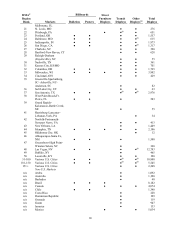iHeartMedia 2006 Annual Report Download - page 19
Download and view the complete annual report
Please find page 19 of the 2006 iHeartMedia annual report below. You can navigate through the pages in the report by either clicking on the pages listed below, or by using the keyword search tool below to find specific information within the annual report.19
of the Communications Act to require an affirmative public interest finding before a broadcast license may be granted to
or held by any such entity, and the FCC has made such an affirmative finding only in limited circumstances. Since we
serve as a holding company for subsidiaries that serve as licensees for our stations, we are effectively restricted from
having more than one-fourth of our stock owned or voted directly or indirectly by non-U.S. citizens or their
representatives, foreign governments, representatives of foreign governments or foreign business entities.
Other Regulations Affecting Broadcast Stations
General. The FCC has significantly reduced its past regulation of broadcast stations, including elimination of
formal ascertainment requirements and guidelines concerning amounts of certain types of programming and commercial
matter that may be broadcast. There are, however, statutes and rules and policies of the FCC and other federal agencies
that regulate matters such as network-affiliate relations, the ability of stations to obtain exclusive rights to air syndicated
programming, cable and satellite systems’ carriage of syndicated and network programming on distant stations, political
advertising practices, obscenity and indecency in broadcast programming, application procedures and other areas
affecting the business or operations of broadcast stations.
Indecency. Provisions of federal law regulate the broadcast of obscene, indecent or profane material. The FCC
has substantially increased its monetary penalties for violations of these regulations. Legislation enacted in 2006
provides the FCC with authority to impose fines of up to $325,000 per violation for the broadcast of such material. We
cannot predict whether Congress will consider or adopt further legislation in this area.
Public Interest Programming. Broadcasters are required to air programming addressing the needs and interests
of their communities of license, and to place “issues/programs lists” in their public inspection files to provide their
communities with information on the level of “public interest” programming they air. In October 2000, the FCC
commenced a proceeding seeking comment on whether it should adopt a standardized form for reporting information on
a station’s public interest programming and whether it should require television broadcasters to post the new form - as
well as all other documents in their public inspection files - either on station websites or the websites of state
broadcasters’ associations. Moreover, in August 2003 the FCC introduced a “Localism in Broadcasting” initiative that,
among other things, has resulted in the creation of an FCC Localism Task Force, localism hearings at various locations
throughout the country, and the July 2004 initiation of a proceeding to consider whether additional FCC rules and
procedures are necessary to promote localism in broadcasting.
Equal Employment Opportunity. The FCC’s equal employment opportunity rules generally require
broadcasters to engage in broad and inclusive recruitment efforts to fill job vacancies, keep a considerable amount of
recruitment data and report much of this data to the FCC and to the public via stations’ public files and websites. The
FCC is still considering whether to apply these rules to part-time employment positions. Broadcasters are also obligated
not to engage in employment discrimination based on race, color, religion, national origin or sex.
Digital Radio. The FCC has approved a technical standard for the provision of “in band, on channel” terrestrial
digital radio broadcasting by existing radio broadcasters (except for nighttime broadcasting by AM stations, which is
undergoing further testing), and has allowed radio broadcasters to convert to a hybrid mode of digital/analog operation
on their existing frequencies. We and other broadcasters have intensified efforts to roll out terrestrial digital radio
service. The FCC has commenced a rulemaking to address formal standards and related licensing and service rule
changes for terrestrial digital audio broadcasting. We cannot predict the impact of terrestrial digital audio radio service
on our business.
Low Power FM Radio Service. In January 2000, the FCC created two new classes of noncommercial low
power FM radio stations (“LPFM”). One class (LP100) is authorized to operate with a maximum power of 100 watts and
a service radius of about 3.5 miles. The other class (LP10) is authorized to operate with a maximum power of 10 watts
and a service radius of about 1 to 2 miles. In establishing the new LPFM service, the FCC said that its goal is to create a
class of radio stations designed “to serve very localized communities or underrepresented groups within communities.”
The FCC has authorized a number of LPFM stations. In December 2000, Congress passed the Radio Broadcasting
Preservation Act of 2000. This legislation requires the FCC to maintain interference protection requirements between
LPFM stations and full-power radio stations on third-adjacent channels. It also requires the FCC to conduct field tests to
determine the impact of eliminating such requirements. The FCC has commissioned a preliminary report on such impact
and on the basis of that report, has recommended to Congress that such requirements be eliminated. We cannot predict
the number of LPFM stations that eventually will be authorized to operate or the impact of such stations on our business.
Other. The FCC has adopted rules on children’s television programming pursuant to the Children’s Television
Act of 1990 and rules requiring closed captioning of television programming. The FCC has also taken steps to
























